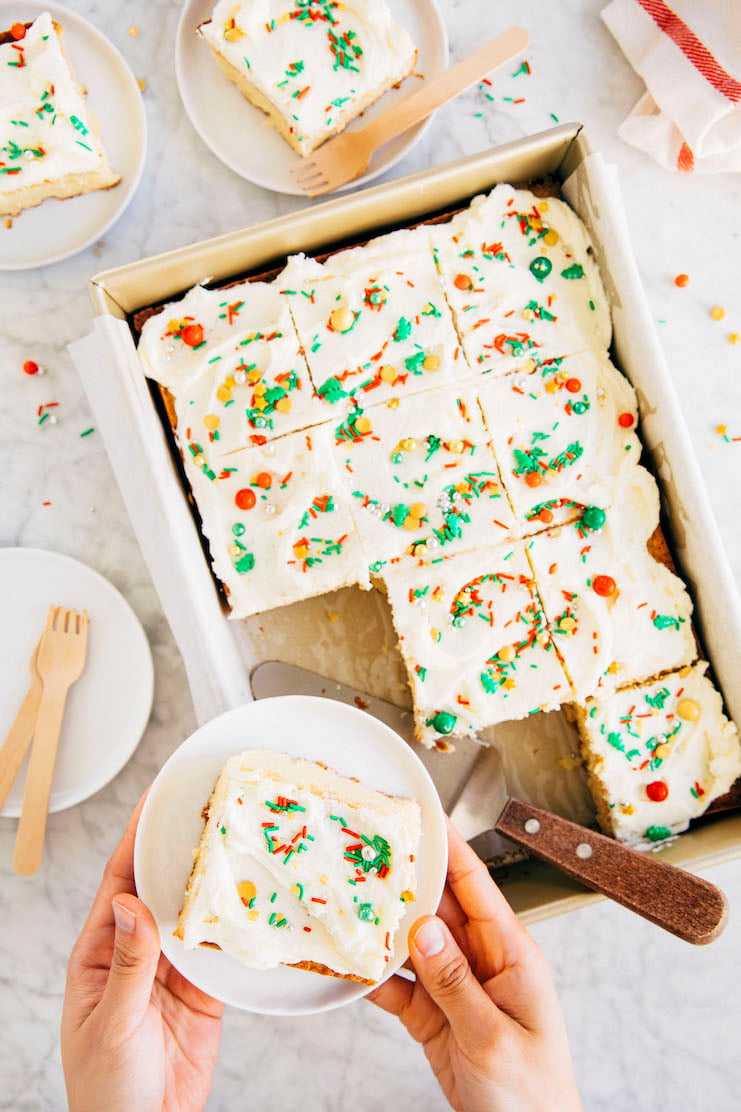
Eggnog Cake
Eggnog cake is a fun, holiday twist on a classic yellow sheet cake with American buttercream frosting. The yellow cake recipe uses eggnog in place of buttermilk to make an incredibly delicious, moist, and lightly spiced eggnog-flavored sponge cake. And for extra flavor, I also instruct you to use eggnog in the frosting! Don’t forget to top everything off with your favorite holiday themed sprinkles.
What is eggnog?
Eggnog is an egg and milk-based drink typically consumed during the Christmas seasons in parts of North and South America. It can be served cold or warm, as well as spiked with an alcohol like brandy, rum, or whiskey.
Traditionally, eggnog was a homemade recipe. However, in most recent years, many grocery stores started selling commercially prepared eggnog that is only sold seasonally during winter months.
What’s in eggnog?
Traditionally, eggnog is made with milk and/or cream, whole eggs and/or additional egg whites and yolks, sugar, and spices like cinnamon, nutmeg, and even cocoa.
What does eggnog taste like?
Eggnog tastes like a sweet milky beverage subtly spiced with warming spices and whatever alcohol is in it (if using alcohol). However Its consistency is thicker than regular milk. Instead, it is more similar in texture to that of heavy cream or melted ice cream. As a result, it is often served as a dessert drink, similar to how you would serve coffee, tea, or hot cocoa after a meal.
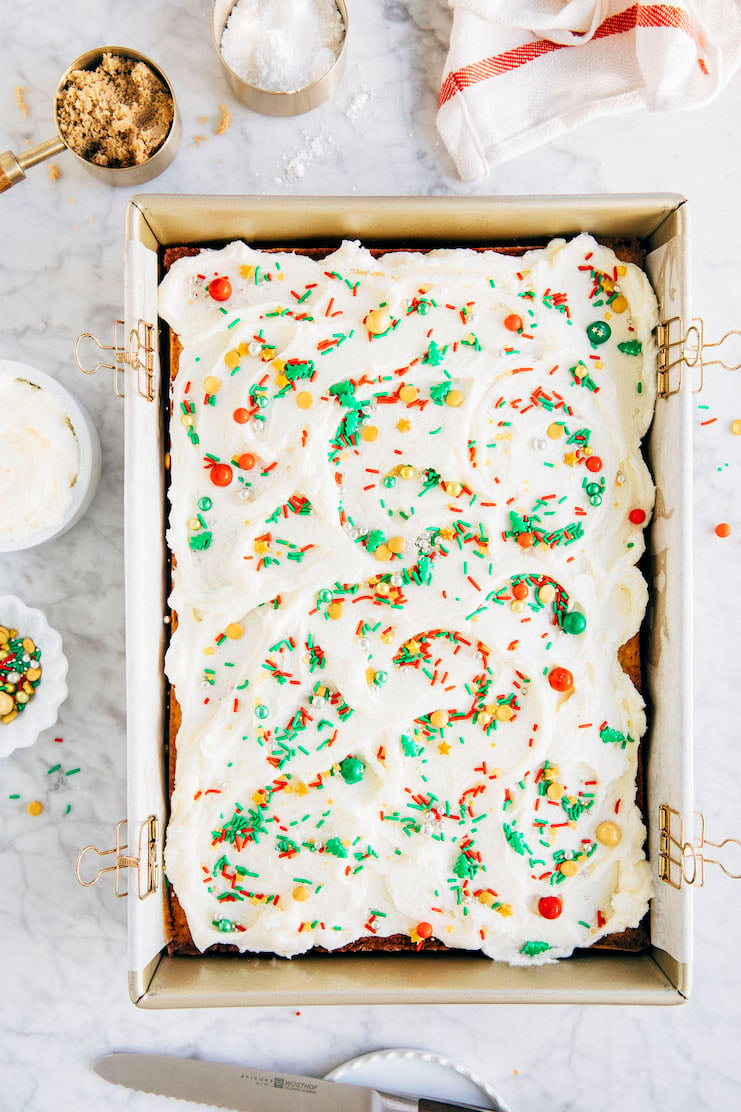
Why You Should Make This Eggnog Cake Recipe
Here are all the reasons to make this eggnog cake:
This eggnog cake is a holiday twist on a classic birthday cake recipe!
December babies, this recipe is for you! If you’re looking for a dessert recipe that celebrates both your birthday AND the holiday season, I highly recommend trying this eggnog cake. I actually based this eggnog cake on my favorite yellow sheet cake recipe that I make for birthdays (see: Strawberry Yellow Sheet Cake for Nine Years of Hummingbird High). I used eggnog in place of buttermilk and whole milk in the recipe. Doing so gives the cake a gently spiced holiday flavor!
This eggnog cake comes together quickly and easily.
One of the reasons why I love my yellow cake recipe is that it uses a slightly unusual (but easy!) method for mixing the batter. Most traditional cake recipes instruct you to cream butter and sugar. After, you’re often instructed to add the eggs, then add the dry ingredients and wet ingredients in alternating parts.
This eggnog cake recipe is a little more unusual. The recipe instructs you to beat the butter and sugars, then add the eggs, eggnog, vanilla, and finally, the dry ingredients. There’s no need to alternate adding them in parts, making your life just ever-so-slightly easier. The frosting is a breeze, too! Unlike meringue based buttercream frostings, this eggnog buttercream comes together in just 5 minutes.
This eggnog cake stores well.
Because this eggnog cake contains a LOT of everything (seriously—it has a ton of sugar, eggs, and eggnog), it keeps incredibly well. It stays moist and fresh for up to 3 days after it’s made (though real talk—I was still eating it on Day 5 and enjoying myself.) I actually even found that I liked the cake better the day after I first baked it. Why? The eggnog flavors became more pronounced the next day, making it taste extra HOLIDAY.
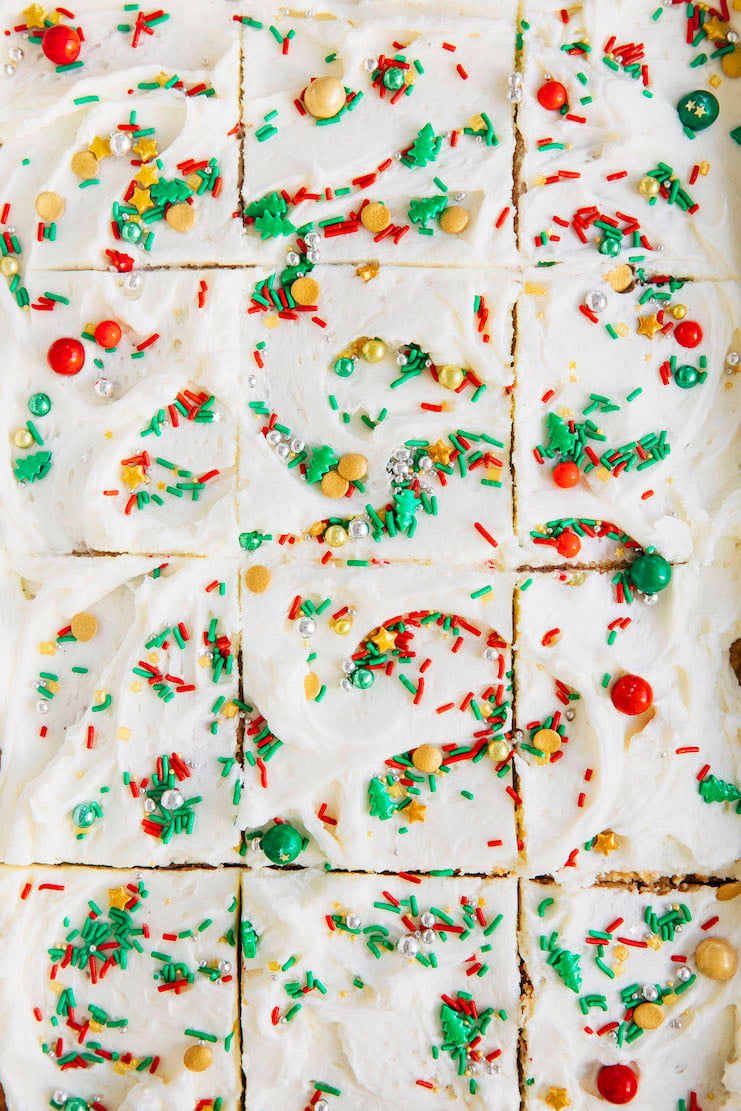
Ingredients and Substitutions
Now that I’ve convinced you to make this eggnog cake, here’s everything you need for the recipe:
Shopping List for Eggnog Cake Recipe
Be sure to scroll down to the recipe card for the exact ingredient quantities:
- cake flour
- baking powder
- kosher salt
- unsalted butter
- granulated sugar
- light OR dark brown sugar
- large eggs
- canola oil
- eggnog
- pure vanilla extract
- confectioners’ sugar
- sprinkles
And let’s talk about some key ingredients and potential substitutions:
Cake Flour
You need 2 cups cake flour to make the cake for this eggnog cake recipe.
Cake Flour versus All-Purpose Flour
In the grocery store, you’ll likely find an aisle of more flour varieties htan you would have thought existed: all-purpose, bread, cake, pastry, and many more. These varieties are defined by their protein percentages. Cake flour contains less protein than all-purpose flour. As a result, using cake flour in a cake recipe results in a cake with a softer and more tender crumb. If you need a brand recommendation, my favorite cake flour is Swans Down Cake Flour.
Can I use all-purpose flour instead of cake flour?
Yes! But it’s not a 1:1 volume substitution. 1 cup of cake flour (4 ounces or 113 grams) tends to weigh less than 1 cup of all-purpose flour (4.5 ounces or 128 grams). So if you’re planning on using all-purpose flour instead, you need to swap out the cake flour with 1 ¾ cups all-purpose flour. However, note that using all-purpose flour in this recipe results in a heavier, slightly denser and breadier cake crumb.
Kosher Salt
You need 1 teaspoon kosher salt to make the cake for this eggnog cake recipe, plus another pinch to make its frosting.
Why You Should Use Kosher Salt When Baking
I like to use kosher salt (as opposed to table salt) when baking. Its larger crystals make it difficult to confuse with granulated sugar. However, not all kosher salts are created equal. Some kosher salts have smaller granules than others, which will result in saltier tasting baked goods.
For consistency, I recommend sticking to one brand, and one brand only: Diamond Crystal kosher salt. It’s the only brand of salt I use when I develop recipes for Hummingbird High. Why? Diamond Crystal kosher salt is one of the few 100% pure salts in the grocery store. Other brands have additives that can add unexpected flavors to your desserts.
I can’t find Diamond Crystal kosher salt. Is Morton’s Coarse kosher salt okay?
Yes, with reservations. Morton’s Coarse kosher salt granules are much smaller, denser, and crunchier than Diamond Crystal. According to this Food52 article, the two are different shapes and sizes because of how they’re made. Morton’s is made by flattening salt granules into large thin flakes by pressing them through high-pressure rollers, whereas Diamond Crystal is formed by a patented method in which “upside-down pyramids [are] stacked one over the next to form a crystal.” You can even see a visualization of the different sizes in this Cook’s Illustrated article.
Okay, but what does that mean, exactly? 1 teaspoon of Morton’s will taste saltier than 1 teaspoon of Diamond Crystal. Wild, right? So if you follow my recipes exactly as they are written but use Morton’s instead of Diamond Crystal, the results will come out saltier. In fact, sometimes they will come out TOO salty. So if you’re using Morton’s instead of Diamond Crystal, reduce the salt in the recipe by half.
Want to learn more about Diamond Crystal versus Morton’s Coarse kosher salt? Definitely check out the Food52 and Cook’s Illustrated articles I linked to above, as well as this Taste article.
I can’t find Diamond Crystal OR Morton’s Coarse kosher salt. Can I just use table salt?
Yes, with reservations. If you use table salt, you’ll need to reduce the recipe’s salt quantity by half.
If you read my little essay about Diamond Crystal and Morton’s, you learned that Diamond Crystal kosher salt granules are larger than Morton’s kosher salt granules. The same principle applies to table salt versus kosher salt. Table salt granules are much smaller than kosher salt granules. As a result, 1 teaspoon of table salt tastes much saltier than 1 teaspoon of kosher salt… simply because it can hold more granules! Wild, right?
So if you follow my recipes exactly as they are written but use table salt instead of kosher salt, the results will come out saltier. If you’re using table salt instead of kosher salt, I recommend reducing the salt in the recipe by half.
Brown Sugar
You need ⅓ cup light OR dark brown sugar to make the cake for this eggnog cake recipe.
Light versus Dark Brown Sugar
Brown sugar is granulated white sugar with a touch of molasses to give it its signature color and flavor. Because brown sugar contains molasses, it adds more moisture baked goods than granulated sugar otherwise would. Brown sugar is available in two varieties: light or dark. Dark brown sugar is my personal preference; because it contains more molasses, I find it to be more flavorful. However, you can use either in this recipe without altering its flavor too much.
Canola Oil
You need ⅔ cup canola oil to make the cake for this eggnog cake recipe.
Can I use another oil instead?
Yes! You can use whatever oil you have on hand instead. Vegetable oil, grapeseed oil, and peanut oil work best to replace the canola oil because they are also neutral in flavors.
However, you can also use flavored oils like coconut in this recipe. Just note that, similar to using flavored milk above, your cake might have a subtle coconut oil flavor to it, too.
Eggnog
You need ⅔ cup eggnog to make the cake for this eggnog cake recipe, plus another 3 Tablespoons to make its frosting.
The Best Eggnog for This Eggnog Cake Recipe
I’ll admit—I am not an eggnog connoisseur. Most of the store-bought eggnog I’ve tried tastes the same to me! But according to both The Food Network and Serious Eats (two legitimate food sources), Turkey Hill Dairy makes the best eggnog.
But I couldn’t find any Turkey Hill eggnog in the supermarkets in my neighborhood. So I settled for Serious Eats‘ second place contender: Organic Valley Eggnog. I liked it enough that I bought it again to drink after making this cake!
I don’t have/like eggnog. What can I use instead?
If you don’t like eggnog, do you really want to make this eggnog cake? It tastes primarily of eggnog—there’s a lot of eggnog in both the cake and the frosting!
But if you insist, okaaayyy. You can replace the eggnog in the cake with the same amount of buttermilk or whole milk. Doing so will make a pretty standard-issue yellow cake. Similarly, you can replace the eggnog in the frosting with whole milk. Again, doing so will make a pretty standard-issue vanilla buttercream frosting.
Sprinkles
You need holiday sprinkles to garnish this eggnog cake.
I like your holiday sprinkles! Where did you get them from?
Thank you—aren’t they cute? They are the Rockefeller sprinkles from Fancy Sprinkles. You can use the code HUMMINGBIRD15 for a 15%-off discount on your bottle!
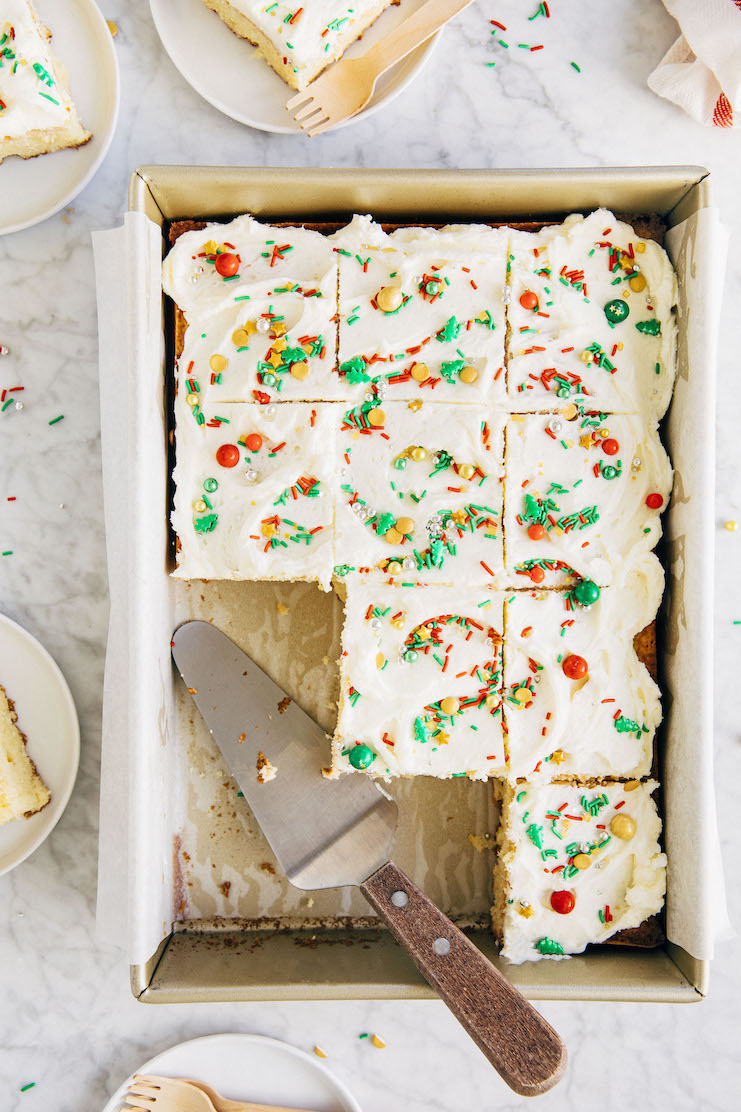
How To Make Eggnog Cake
Here are the basic steps to make eggnog cake from scratch:
First, make the eggnog cake.
- Prep the ingredients for the cake. (Prep Time: 5 minutes)
All you need to do is measure everything out, and make sure that ingredients like butter, eggs, and eggnog are at room temperature. It’s especially important to pay attention to the ingredient temperatures in this recipe. Why? The recipe contains a lot of fat in the form of butter, eggs, and eggnog. You are the instructed to mix all those together. Everything mixes much better (and faster!) If all the ingredients are at room temperature. - Make the cake. (Work Time: 10 minutes)
Once you’ve prepped the ingredients, it’s time to make the cake. First, whisk together dry ingredients like cake flour, baking powder, and kosher salt in a medium bowl. Then, beat together the butter and sugars in a stand mixer until light and fluffy. Add the eggs, oil, eggnog, and vanilla until you get a thick and almost floofy cake batter texture. Finally, mix in the dry ingredients. That’s it! - Bake the cake. (Bake Time: 40 minutes)
Once you’ve made the batter, it’s time to bake the cake! Pour the batter into a 9 x 13-inch baking pan lined with parchment paper. Bake for 40 to 45 minutes, or until a skewer inserted into the center of the cake comes out with just a few crumbs attached.
Next, cool the cake.
- Cool the cake.
Now comes the hard part—cooling the cake! It’s important to wait until the cake is completely cooled before frosting. If you frost the cake while it’s still warm, the frosting will melt all over the place. You’ll just end up with a big mess! So let’s avoid that by cooling the cake in its pan on a wire rack until it’s 100% at room temperature.
Depending on the temperature of your kitchen, doing so could take a while. That’s why when I make frosted cake recipes, I typically make the cakes a day ahead of frosting and assembling everything. Doing so ensures that my cakes are completely cool when I finally assemble everything! Plus, I’m not stuck waiting for what feels like forever for the cakes to cool. I can just go live my life, knowing I’ve planned to finish assembling everything the next day.
Then, make the eggnog frosting.
- Prep the ingredients for the frosting. (Prep Time: 5 minutes)
Prepping the ingredients for the frosting is super easy, too. All you need to do is measure everything out, and make sure that the butter and eggnog for the frosting is at room temperature.
If you look at my ingredients closely, note that I don’t even instruct you to sift the confectioners’ sugar. That’s not an accident. In this recipe, there’s no need to even sift the confectioners’ sugar beforehand! Because you’ll be beating the frosting at high speeds, most of the lumps will work themselves out in the mixer. - Make the frosting. (Work Time: 5 minutes)
The frosting comes together VERY quickly. Beat the butter in the stand mixer until smooth and creamy, about 1 minute. Then, gradually add the confectioners’ sugar 1 cup or so at a time, scraping the bowl with a rubber spatula as necessary. Once all the confectioners’ sugar is added, add the eggnog and salt. Now comes the fun part—beat on medium-high speed until the frosting is very creamy and smooth, another 2 to 3 minutes.
Finally, assemble the cake.
- Frost the cake. (Work Time: 5 minutes)
Once you’ve made the frosting, it’s time to assemble the cake! I unceremoniously scoop al the frosting on top of the cake. Then, I use a long offset spatula to spread it all over the cake. Once I’m done, I make random swoops and swirls with the spatula all over the frosting and immediately garnish with my holiday sprinkles. The whole assembly and decorating process legit only takes me 5 minutes!
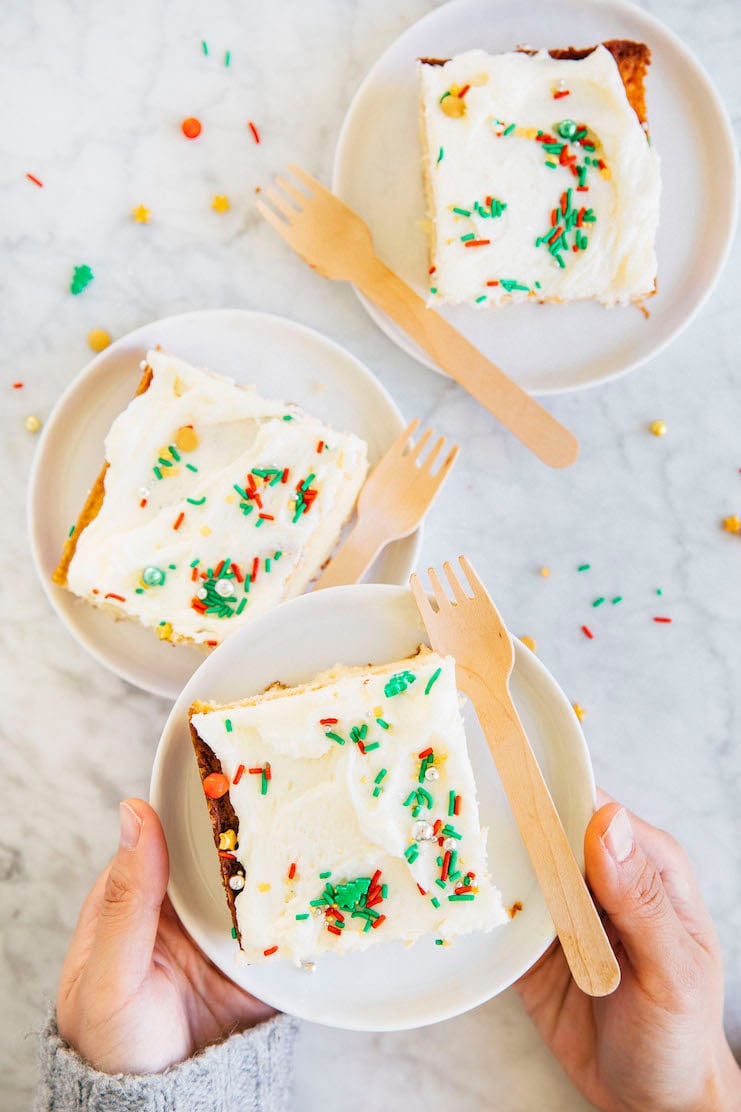
Recipe Troubleshooting and FAQ
FAQ: Baking Equipment and Tools Needed To Make Eggnog Cake
Can I use a handheld electric mixer instead of a stand mixer to make this eggnog cake?
Yes! If you don’t own a stand mixer, you can still make this recipe with a handheld electric mixer. Just follow the instructions to mix everything—the only difference is that you may need to add a couple of minutes to my mixing times below. A handheld electric mixer isn’t as powerful as a stand mixer, and usually requires 1 to 2 minutes of extra mixing to get the same results.
What’s an offset spatula?
While spatulas for cooking have a wide rectangular or square head, offset spatulas have a thin, blunt blade. This blade enables you to easily spread and scrape sauces, fillings, frostings and more when baking. If you don’t already own one, I recommend investing in both a short and long offset spatula with sturdy metal blades. These ones from Ateco are my favorites.
Do I really need an offset spatula to decorate this eggnog cake?
Absolutely not (though having one on hand will make your life easier).
If you don’t own an offset spatula, you can use a butter knife to spread the frosting around the cake (just like you would butter on toast, basically). Then, use the back of a spoon to create random swoops and swirls on the frosting. BOOM—the same effect but with lo-fi tools! You know I got yo’ back.
FAQ: Customizing This Eggnog Cake Recipe With Different Pans
I don’t own a 9 x 13-inch cake pan. Can I make this as a layer cake instead?
Yes! If you want to make this recipe as a layer cake, you have two options. You can bake the batter in two 8-inch OR 9-inch round cake pans to make a 2-layer cake. Follow the recipe instructions to make the batter, then divide it in half between the two cake pans.
If you’re baking the batter in 8-inch cake pans, Bake Time will stay the same at 40 minutes. If you’re baking the batter in 9-inch cake pans, you’ll need to adjust the Bake Time to 35 minutes. However, I would start checking for doneness a little earlier at 30 minutes.
FAQ: Making This Eggnog Cake Fit Into Your Schedule
Can I make the eggnog cake batter and refrigerate it until I’m ready to bake and assemble the cake?
In theory, yes, but I don’t recommend it. You can technically make the cake batter up to 3 days before baking it. However, I don’t recommend it.
Why? The cake has a tendency to dome the longer the batter sits in the refrigerator. There’s a lot of science behind why—the TL/DR is that it has to do with hydration levels (how much liquid the flour can absorb) and its varying effects on the baked cake’s gluten and structure. I don’t know if you guys are really interested in that, so I won’t go into it any further (unless you email me to geek out and discuss!).
And while doming is a desirable quality for muffins (see: Small Batch Blueberry Muffins, Small Batch Pumpkin Muffins), it’s not great for sheet cakes. Think about it—when have you ever seen a sheet cake that domed? Most of them are flat across their top, right? Right. So if you want to avoid that, don’t make your batter ahead (unless you don’t mind leveling its top, which comes with its own set of problems).
Okay, that makes sense. But I still don’t have time to make this eggnog cake all at once. What can I do instead?
If you don’t have time to bake the cake, make the frosting, and assemble and decorate it all in one day, no worries! What I recommend instead is baking the cake a day ahead, and then making the frosting and assembling the entire cake the next day.
The cake will keep well tightly wrapped in plastic wrap, just on your countertop (there’s no need to refrigerate the baked cake).Then, whenever you’re ready to serve the cake, make the frosting and assemble everything right before serving!
IMO, this is the way to go. I actually think the cake’s flavors are better after an overnight rest since the eggnog flavor becomes more pronounced the longer it sits.
FAQ: Storing and Freezing Eggnog Cake
How To Store Eggnog Cake
The eggnog cake will keep, covered tightly in plastic wrap, at room temperature for up to 1 day. After that, refrigerate it for up to 3 more days. Unlike other sheet cakes, I don’t recommend leaving the eggnog cake out at room temperature. The cake has eggnog in its frosting, making it prone to spoiling more quickly.
Can you freeze eggnog cake?
Yes, you can freeze the eggnog cake in the following ways:
Freeze the unfrosted eggnog cake for frosting later.
Follow the recipe instructions to make and bake the eggnog sheet cake. However, don’t make the frosting! Instead, cool completely on a wire rack. Once cool, tightly wrap the cake, still in its sheet pan, in plastic wrap. Freeze for up to 3 months.
When ready to serve, thaw in the refrigerator overnight. Then, thaw at room temperature for 5 t0 10 minutes while you prep and make the frosting. Doing so will prevent condensation from the cake from bleeding through the frosting. Follow the recipe instructions to assemble and decorate the cake.
Freeze any leftover slices of the assembled eggnog sheet cake.
Tightly wrap any leftover slices of cake in plastic wrap and freeze for up to 3 months. To serve, transfer to the refrigerator to thaw overnight. Eat chilled, or rewarm for 10 to 20 second intervals in the microwave until room temperature.
More Sheet Cake Recipes
- Baileys Tres Leches Cake
- Small Batch Funfetti Cake
- Small Batch Strawberry Cake
- Strawberry Yellow Sheet Cake
- Texas Sheet Cake Recipe For 9 x 13 Inch Pan
More Holiday Cake Recipes
- Christmas Wreath Cake
- Chocolate Chestnut Yule Log
- Kentucky Bourbon Butter Cake
- Pink Champagne Cake
- Holiday Sweater Cake
- Vanilla Mille Crepe Cake
Get the Recipe: Eggnog Cake Recipe
Ingredients
For the Cake
- 2 cups (8 ounces or 227 grams) cake flour
- 1 teaspoon baking powder
- 1 teaspoon kosher salt
- ⅔ cup (5.35 ounces or 152 grams) unsalted butter, at room temperature
- 1 ⅔ cups (11.65 ounces or 330 grams) granulated sugar
- ⅓ cup tightly packed (2.5 ounces or 71 grams) light OR dark brown sugar
- 4 large eggs, at room temperature
- ⅔ cup (5.35 ounces or 152 grams) canola oil
- ⅔ cup (5.35 ounces or 152 grams) eggnog, at room temperature
- 1 teaspoon pure vanilla extract
For the Frosting
- ¾ cup (6 ounces or 170 grams) unsalted butter, at room temperature
- 3 cups (12 ounces or 340 grams) confectioners' sugar
- 3 Tablespoons eggnog, at room temperature
- pinch of kosher salt
Assembly
- sprinkles, for garnish
Equipment
- stand mixer with paddle attachment
- an offset spatula
Instructions
For the Eggnog Cake
- First, make the cake. Position a rack in the center of the oven and preheat the oven to 350°F. Generously spray a 9 x 13-inch cake pan with cooking spray and line the bottom with parchment paper.
- Mix the dry ingredients. In a medium bowl, whisk together the flour, baking powder, and salt.
- Cream the butter and sugars. In the bowl of a stand mixer fitted with the paddle attachment, combine the butter and sugars. Beat on medium until light, fluffy, and doubled in volume, 3 to 4 minutes, using a rubber spatula to scrape down the bottom and sides of the bowl as necessary.
- Add the eggs, oil, eggnog, and vanilla. Reduce the mixer to low and add the eggs one at a time, adding the next egg only after the previous one has been fully incorporated, scraping down the bottom and sides of the bowl after each addition. With the mixer on low, slowly pour in the oil, followed by the eggnog and vanilla, and beat until the mixture is smooth, 3 to 4 minutes.
- Add the dry ingredients. Gradually add the dry ingredients and beat until just combined. Scrape down the bottom and sides of the bowl once more, and beat on low for an additional 30 seconds.
- Assemble and bake the cake. Pour the batter into the prepared pan. Bake for 40 to 45 minutes, or until the top of the cake bounces back when gently pressed. A skewer inserted into the center of the cake should come out with a few crumbs attached.
- Cool the cake. Cool completely in the pan on a wire rack before frosting.
- Once the cake is cool, make the frosting. In the bowl of a stand mixer fitted with the paddle attachment, beat the butter on medium-low until smooth and creamy, about 1 minute.Reduce the mixer to low and add the confectioners' sugar 1 cup at a time, beating until combined. Scrape down the bottom and sides of the bowl with a rubber spatula.Add the eggnog and salt for the frosting all at once and beat on low just to incorporate the liquid. Scrape down the bottom and sides of the bowl once more, then beat on medium-high until the frosting is creamy and smooth, 2 to 3 minutes.
- Assemble the cake. Use an offset spatula to spread the frosting on top of the cake. Then, use the spatula to make large, random sweeping motions across the frosting. The sweeping motions will create swirls. Garnish with sprinkles.
- Serve and store. Serve immediately, or cover loosely with plastic wrap and refrigerate for up to 3 days.
Did you make this recipe?
Please leave a comment and rating for the recipe using the form below!
Your ratings make it easier to find the recipe online, and I’m always looking for ways to improve Hummingbird High.

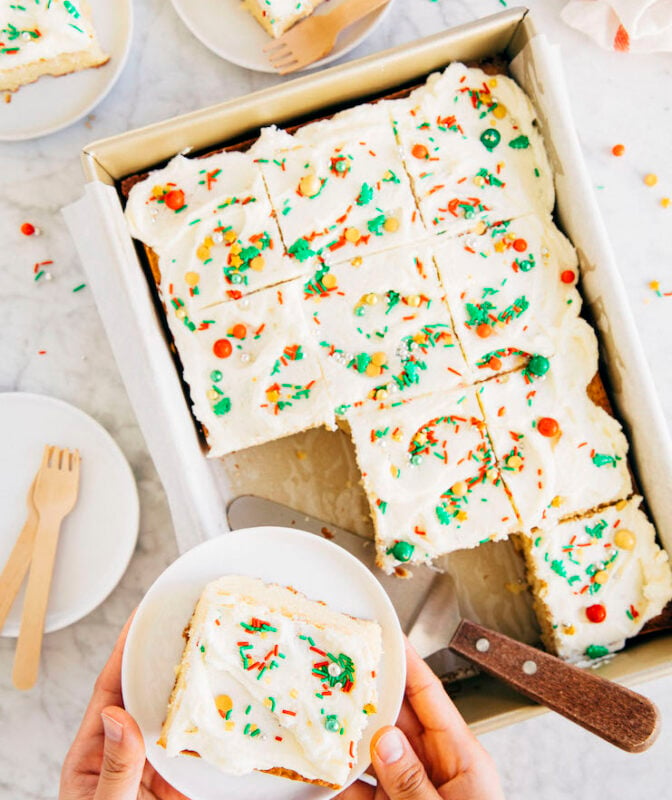
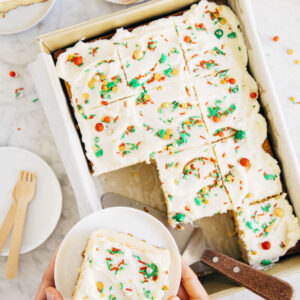


Can a Bundt cake pan be used instead of a 9X14 baking sheet? Thanks & Happy Holidays!
I think you might need more batter to fill a bundt cake pan. Maybe 1.5x the recipe quantities?